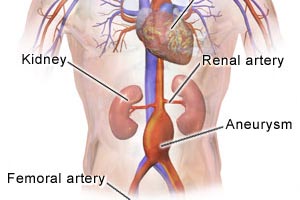Silent and Deadly

An abdominal aortic aneurysm is a focal enlargement or dilation of the artery in the abdomen.
About 15,000 Americans die each year from ruptured abdominal aortic aneurysms (AAAs), according to a study by the Mayo Clinic. Dixon Santana, M.D., Texas Tech Physicians Surgery, reminds us that many of these deaths could have been prevented if patients were aware of this often silent but treatable condition.
An AAA is a focal enlargement or dilation of the artery in the abdomen, making the abdomen wall extremely thin and at risk of tearing. AAAs grow in the back of a person’s abdomen and cannot always be felt by a physician during an abdominal examination. In addition, AAAs rarely have any warning symptoms. Incidentally, most AAAs are found during an abdominal ultrasound or CT scan ordered for an unrelated reason.
AAAs are more common in men than women, and have a 5 percent incidence individuals over 60 years old. That incidence increases to 20 percent in people who have a close relative with an AAA. Other risk factors associated with the development of an AAA include race, obesity, smoking and high blood pressure.
As AAAs grow, they become potentially life threatening. The risk of rupture increases with size, smoking and history of high blood pressure. A 4-centimeter aneurysm has a five-year risk of 15 percent, but increases to a five-year risk of 75 percent when it grows to 8 centimeters or more. The death rate of rupture can be as high as 80 percent, so it is highly recommended to treat AAAs when they measure 5 centimeters or greater.
There are two ways to treat an AAA: an open surgery where the section of the artery is replaced with a tube graft or conduit, or a stent placed inside the artery as a pipe inside another one to fix the damaged section. Both methods are safe and potentially lifesaving. The open surgery requires a large incision in the abdomen and the stent option is usually done through one or two smaller incisions in the groin.
There are several specialists trained to perform these surgeries and the extent of treatment options offered depends on training. Cardiologists and interventional radiologists will only perform the stent option, cardiovascular surgeons offer the open option for most, and vascular surgeons will offer both depending on a patient’s particular situation and anatomy.
If you are over 60, have a relative diagnosed with an AAA, smoke, have high blood pressure, or are concerned about your risk of an AAA, contact your doctor and ask him or her to run an abdominal ultrasound or refer you to a specialist.
Related
Related Stories
Celebrating Veterans: TTUHSC’s General Martin Clay’s Legacy of Service and Leadership
From his initial enlistment in the Army National Guard 36 years ago to his leadership in military and civilian health care management roles, Major General Martin Clay’s career has been shaped by adaptability, mission focus and service to others.
Texas Tech University Health Sciences Center School of Nursing Named Best Accelerated Bachelor of Science in Nursing Program in Texas
The TTUHSC School of Nursing Accelerated Bachelor of Science in Nursing (BSN) program has been ranked the No. 1 accelerated nursing program in Texas by RegisteredNursing.org.
TTUHSC Names New Regional Dean for the School of Nursing
Louise Rice, DNP, RN, has been named regional dean of the TTUHSC School of Nursing on the Amarillo campus.
Recent Stories
Abid Brings Hematology Expertise to TTUHSC Oncology Team
Muhammad Bilal Abid, M.D., has joined the TTUHSC School of Medicine oncology team as an associate professor of internal medicine and medical director of TTUHSC’s Blood and Marrow Transplantation & Cellular Therapy Program.
Research Team Studies Cardiovascular Disease Risk in Homeless Population
A team of student researchers from TTUHSC and TTU evaluated differences in CVD risk between men and women experiencing poverty and homelessness in West Texas, a medically underserved region within the TTUHSC service area.
Clinical Trials Provide Access to Latest Cancer Interventions
Beginning in 2008, TTUHSC, through the School of Medicine Pediatric Cancer Research Center in 2025, has conducted multiple phase 1 oncology clinical trials for pediatric and adult cancer patients. These trials will pave new ground for patients now and in the future.
